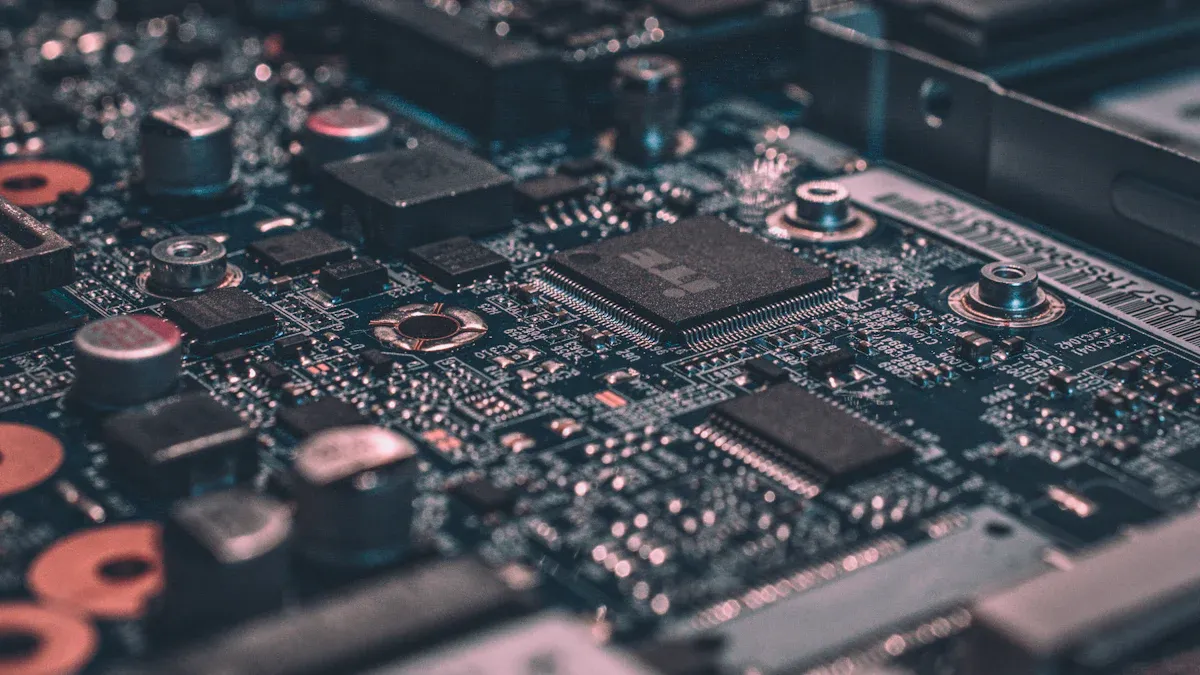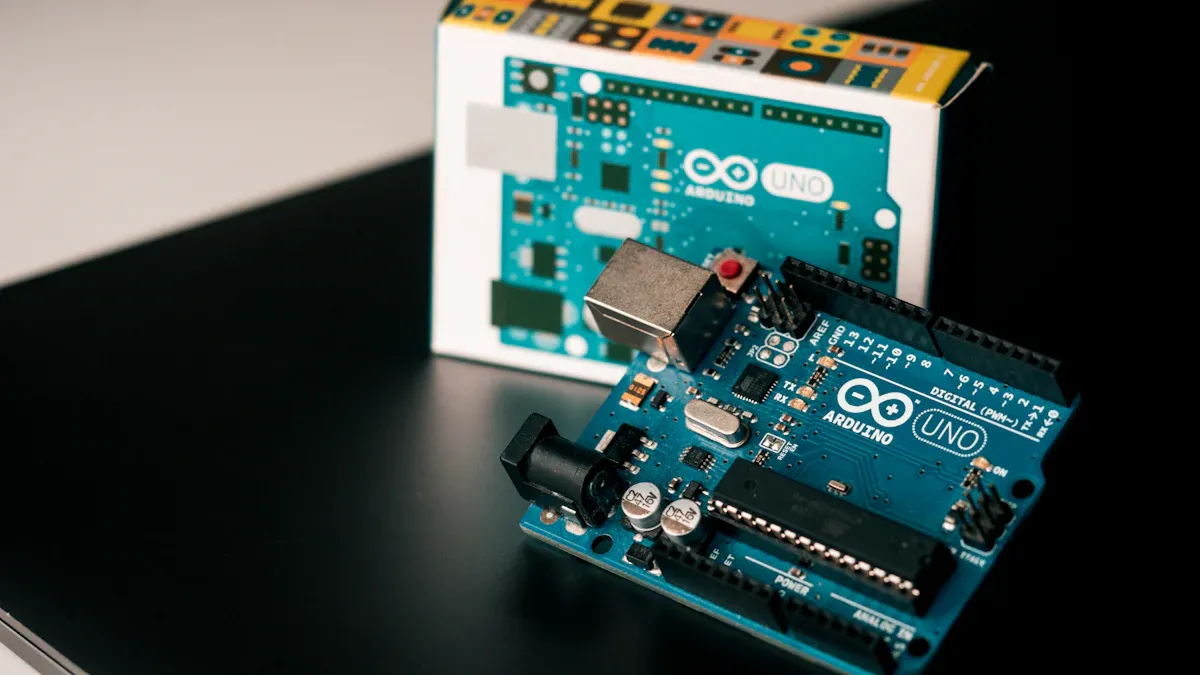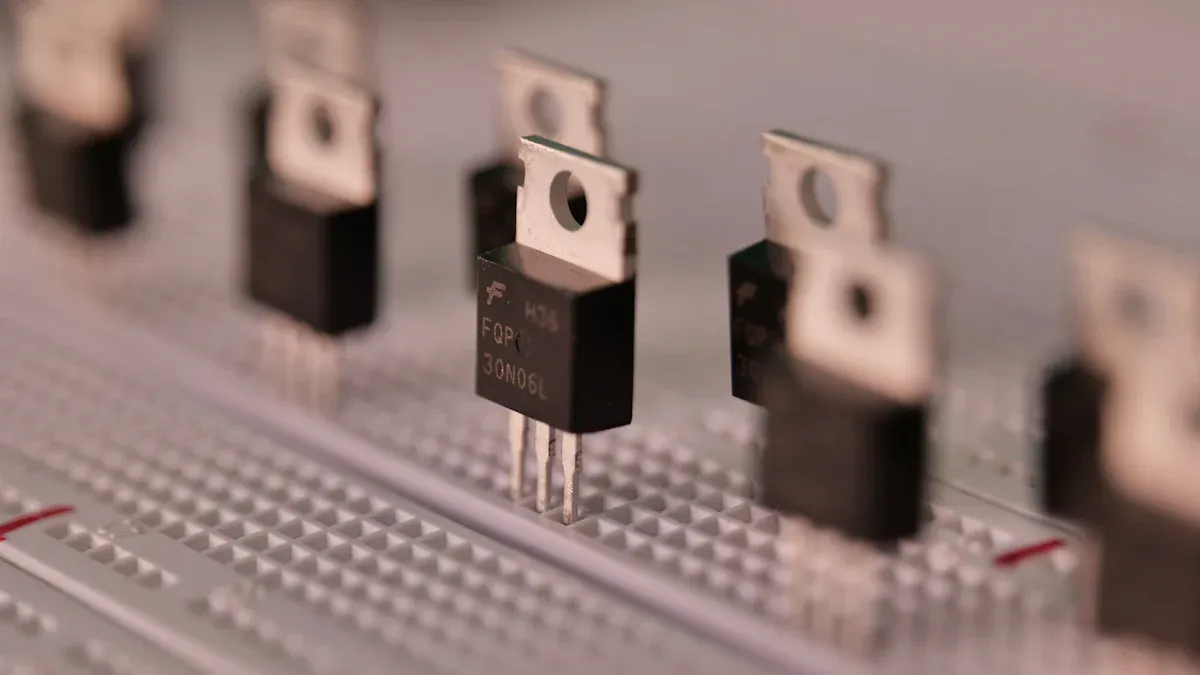What Are P-channel Powertrench MOSFETs and Their Applications

P-channel Powertrench MOSFETs are specialized transistors used to control current flow in electronic circuits. They play a vital role in managing power efficiently, especially in systems requiring high-side switching. In these setups, the source connects to the positive supply, while the drain links to the load. By applying a negative gate-to-source voltage (Vgs), you can turn the MOSFET on, allowing current to flow. Switching it off is equally simple—just pull the gate voltage to the supply level.
These components are highly valued for their simplicity, cost-effectiveness, and reliability. Unlike N-channel MOSFETs, they need only basic gate drive circuits and are less prone to damage from gate oxide breakdown, making them ideal for high-voltage applications. Their design ensures seamless operation in modern electronic devices.
Key Takeaways
P-channel Powertrench MOSFETs make switching easier and need fewer parts.
They use less energy because of low resistance, perfect for gadgets.
Powertrench tech keeps them cool, so they handle more power safely.
Check voltage and current limits to avoid heat and work better.
Try simulation tools to test your design and fix problems early.
What Are P-channel Powertrench MOSFETs?

Definition and structure
P-channel Powertrench MOSFETs are specialized transistors designed to control current flow in electronic circuits. Their internal structure is carefully engineered to optimize performance and reliability. Here's a breakdown of their components:
Substrate: The foundation is made of p-type silicon, which supports the entire device.
Source and Drain Regions: These regions are created using n-type doping, defining the entry and exit points for current.
Gate Insulator: A thin layer of silicon dioxide separates the gate from the semiconductor, preventing direct contact.
Metal Gate: Typically made of aluminum or polysilicon, this component regulates current flow by creating a conductive channel between the source and drain when a negative voltage is applied.
This design ensures efficient operation, making P-channel Powertrench MOSFETs essential for applications requiring high-side switching and power management.
Key differences from N-channel MOSFETs
When comparing P-channel MOSFETs to their N-channel counterparts, several distinctions emerge. These differences influence their performance and suitability for specific applications.
Characteristic | N-channel MOSFET | P-channel MOSFET |
|---|---|---|
Packing Density | Higher packing density, smaller size | Lower packing density, larger size |
Switching Speed | High due to electron mobility | Low due to hole mobility |
ON Resistance | Low | High |
Charge Carrier | Electrons | Holes |
Heat Production | Less heat | More heat |
Input Noise | Low | High |
N-channel MOSFETs require a positive gate-source voltage to activate, while P-channel MOSFETs need a negative gate-source voltage. The key distinction lies in their charge carriers. P-channel MOSFETs rely on holes, which move slower than electrons, resulting in higher ON resistance and lower switching speeds. Despite these limitations, P-channel Powertrench MOSFETs excel in high-side switching applications where simplicity and reliability are critical.
Overview of Powertrench technology
Powertrench technology enhances the performance of MOSFETs by optimizing their structure to reduce losses and improve efficiency. This innovative approach focuses on minimizing the resistance in the drift region, which is a critical area where current flows. By refining the drift region current model and capacitance behaviors, Powertrench technology achieves lower ON resistance and better thermal performance.
You benefit from this technology in applications requiring compact designs and high efficiency. Devices equipped with Powertrench MOSFETs operate cooler and more reliably, even under demanding conditions. This makes them ideal for modern electronic circuits, where space and energy efficiency are paramount.
Key Features of P-channel Powertrench MOSFETs
Low on-resistance and efficiency
One of the standout features of P-channel Powertrench MOSFETs is their low on-resistance, which directly impacts efficiency. Lower resistance means less energy is lost as heat, allowing your circuits to operate more effectively. This is especially important in power-sensitive applications like portable devices and automotive systems.
To illustrate, consider the following performance benchmarks:
Type | Vds (V) | Id (mA) | Output Resistance (kOhm) |
|---|---|---|---|
NMOS | 5.0 | 0.999 | 161 |
NMOS | 10.0 | 1.030 | 161 |
PMOS | 5.0 | 1.000 | 16 |
PMOS | 10.0 | 1.313 | 16 |
As shown, P-channel MOSFETs exhibit significantly lower output resistance compared to N-channel MOSFETs under similar conditions. This characteristic makes them ideal for high-side switching applications where efficiency is critical.
Compact and thermally optimized design
P-channel Powertrench MOSFETs are designed to save space while managing heat effectively. Their compact structure allows you to integrate them into devices with limited board space. Additionally, the Powertrench technology enhances thermal performance by reducing heat generation during operation. This ensures that your circuits remain stable, even under heavy loads.
For example, in battery-powered devices, these MOSFETs help maintain a balance between size and thermal efficiency. This makes them a preferred choice for engineers designing portable electronics.
Enhanced forward-bias safe operating area (FBSOA)
The forward-bias safe operating area (FBSOA) is another critical feature of P-channel Powertrench MOSFETs. It defines the range of voltage and current levels where the device can operate safely without damage. These MOSFETs offer an enhanced FBSOA, allowing you to use them in demanding applications like automotive and industrial systems.
This improvement ensures that the MOSFETs can handle higher power levels without compromising reliability. As a result, they are well-suited for circuits requiring robust performance under varying conditions.
How Do P-channel Powertrench MOSFETs Work?
Operating principle of P-channel MOSFETs
A P-channel MOSFET operates by controlling the flow of current between its source and drain terminals. When you apply a gate voltage lower than the source voltage, the MOSFET turns on, allowing current to flow. This happens because the negative gate voltage attracts holes (positive charge carriers) to the gate region, forming a conductive channel. Once the channel forms, current flows from the source to the drain.
The device's behavior can be analyzed using its I-V characteristics. These characteristics help you understand how the MOSFET performs in different circuit conditions. Simulation tools like MATLAB and PSpice are often used to compare theoretical models with real-world data.
Feature | Description |
|---|---|
Analytical | |
Approach | Quasi-static |
Key Effects | Velocity saturation, mobility degradation |
Application | First-order analysis for analog and digital circuits |
This principle makes P-channel Powertrench MOSFETs ideal for applications requiring precise current control, such as power management systems.
Enhancement vs. depletion modes
P-channel MOSFETs can operate in two modes: enhancement and depletion. In enhancement mode, the MOSFET remains off until you apply a gate voltage lower than the source voltage by a specific threshold (Vgs < Vth). This mode is common in modern circuits due to its energy efficiency.
In depletion mode, the MOSFET stays on by default. You need to apply a positive gate voltage to turn it off. This mode is less common but useful in specific applications.
Mode | NMOS Conditions | PMOS Conditions |
|---|---|---|
Enhancement-mode | On: Vg ≥ Vs + 3V, Off: Vg ≤ Vs | On: Vg ≤ Vs - 3V, Off: Vg ≥ Vs |
Depletion-mode | On: Vg ≥ Vs, Off: Vg ≤ Vs - 3V | On: Vg ≤ Vs, Off: Vg ≥ Vs + 3V |
Understanding these modes helps you choose the right MOSFET for your circuit design.
Role of Powertrench technology in performance improvement
Powertrench technology significantly enhances the performance of P-channel MOSFETs. It reduces ON resistance and improves thermal efficiency, allowing your circuits to handle higher power levels without overheating. This technology also minimizes input and output capacitance, which improves switching speeds.
Key advancements include:
A 15% improvement in Figures of Merit (FOMs) for BV²/Ron,sp.
A 25% reduction in gate-drain charge (Qgd).
A 40% boost in Baliga's High-Frequency Figure of Merit (BHFFOM).
These improvements make P-channel Powertrench MOSFETs more efficient and reliable, especially in high-performance applications like automotive and industrial systems.
Applications of P-channel Powertrench MOSFETs

Power management in portable devices
P-channel Powertrench MOSFETs play a crucial role in managing power in portable devices. These MOSFETs help regulate voltage and current, ensuring efficient energy use in devices like smartphones, tablets, and wearables. Their low on-resistance minimizes energy loss, which is essential for extending battery life in portable electronics.
The global market for P-channel MOSFETs reflects their growing importance. In 2022, the market was valued at approximately USD 490 million and is expected to grow at a compound annual growth rate (CAGR) of 4.8% from 2023 to 2030. This growth highlights the increasing demand for low-power, high-efficiency devices in sectors like consumer electronics and automotive. Recent trends also show a surge in adoption due to the need for compact designs and energy-efficient solutions. These factors make P-channel Powertrench MOSFETs indispensable for modern portable devices.
High-side switching in DC-DC converters
High-side switching is a critical function in DC-DC converters, and P-channel Powertrench MOSFETs excel in this application. These MOSFETs simplify circuit design by eliminating the need for complex gate drive circuits. You can use them to control the flow of current from the positive supply to the load, ensuring stable voltage regulation.
Their ability to operate efficiently at high voltages and currents makes them ideal for DC-DC converters in applications like power supplies, renewable energy systems, and electric vehicles. The enhanced forward-bias safe operating area (FBSOA) of these MOSFETs ensures reliable performance even under demanding conditions. This reliability is crucial for maintaining the stability of power systems in both industrial and consumer applications.
Reverse polarity protection in automotive circuits
In automotive circuits, reverse polarity protection is essential to prevent damage caused by incorrect battery connections. P-channel Powertrench MOSFETs provide an effective solution for this challenge. By placing the MOSFET in series with the load, you can block current flow when the polarity is reversed, protecting sensitive components.
Case studies have documented the use of MOSFETs, including those with GaN technology, for reverse polarity protection in automotive systems. These studies highlight their effectiveness in safeguarding circuits against voltage spikes and reverse currents. The robust design of P-channel Powertrench MOSFETs ensures they can handle the harsh conditions of automotive environments, making them a reliable choice for this application.
Battery protection and charging circuits
P-channel Powertrench MOSFETs are essential components in battery protection and charging circuits. These circuits safeguard batteries from overcharging, over-discharging, and short circuits, ensuring their longevity and safety. You can use these MOSFETs to control the flow of current and voltage, providing precise management of battery operations.
In charging circuits, these MOSFETs act as switches to regulate the charging process. When the battery reaches its full charge, the MOSFET disconnects the power source to prevent overcharging. This feature is especially important in lithium-ion batteries, which are sensitive to voltage fluctuations. By integrating a P-channel Powertrench MOSFET, you can achieve efficient and reliable charging while minimizing energy loss.
For battery protection, these MOSFETs block current flow during fault conditions. For instance, if a short circuit occurs, the MOSFET quickly shuts off the current to protect the battery and connected devices. Their low on-resistance ensures minimal power dissipation, which is critical in portable devices where energy efficiency matters most.
Tip: When designing battery protection circuits, always consider the MOSFET's voltage and current ratings. Choosing the right specifications ensures optimal performance and safety.
Industrial and consumer electronics
In industrial and consumer electronics, P-channel Powertrench MOSFETs play a pivotal role in enhancing performance and reliability. These MOSFETs are widely used in applications like motor control, power supplies, and lighting systems. Their ability to handle high voltages and currents makes them ideal for demanding industrial environments.
For consumer electronics, these MOSFETs contribute to the compact and energy-efficient designs of devices like laptops, gaming consoles, and smart home appliances. Their thermally optimized structure ensures stable operation even under heavy loads. You can rely on these MOSFETs to deliver consistent performance, reducing the risk of overheating or failure.
One notable application is in LED lighting systems. These MOSFETs regulate the power supply to LEDs, ensuring uniform brightness and energy efficiency. Their low on-resistance minimizes power loss, making them a cost-effective solution for both residential and commercial lighting.
Note: When using P-channel Powertrench MOSFETs in industrial settings, ensure proper heat dissipation. Adding heat sinks or using thermally conductive materials can improve reliability.
Advantages and Practical Considerations
Benefits of using P-channel Powertrench MOSFETs
P-channel Powertrench MOSFETs offer several advantages that make them a valuable choice for your electronic designs. Their low on-resistance ensures minimal energy loss, which improves efficiency in power-sensitive applications. This feature is especially useful in portable devices where battery life is critical.
Another benefit is their simplified gate drive requirements. Unlike N-channel MOSFETs, P-channel devices do not need complex circuitry for high-side switching. This reduces design complexity and saves space on your circuit board.
You’ll also appreciate their robust thermal performance. Powertrench technology enhances heat dissipation, allowing these MOSFETs to operate reliably under heavy loads. This makes them ideal for demanding environments like automotive and industrial systems.
Tip: If you’re designing for high-voltage applications, P-channel Powertrench MOSFETs provide added reliability due to their enhanced forward-bias safe operating area (FBSOA).
Design considerations for optimal performance
To get the best performance from P-channel Powertrench MOSFETs, you need to focus on a few key design factors. First, always choose a MOSFET with the appropriate voltage and current ratings for your application. Using an underrated device can lead to overheating or failure.
Pay attention to thermal management. Even though these MOSFETs are thermally optimized, adding heat sinks or using thermally conductive materials can further improve reliability.
Minimizing parasitic inductance in your circuit layout is another critical step. Keep the traces between the MOSFET and other components as short as possible. This reduces switching losses and improves overall efficiency.
Note: When designing high-side switching circuits, ensure the gate voltage is sufficiently negative relative to the source to fully turn on the MOSFET.
Common challenges and solutions
You may encounter challenges when using P-channel Powertrench MOSFETs, but most have straightforward solutions. One common issue is higher on-resistance compared to N-channel MOSFETs. To address this, select a device with the lowest possible Rds(on) for your application.
Another challenge is slower switching speeds due to hole mobility. You can mitigate this by optimizing your gate drive circuit to reduce switching delays.
In some cases, thermal runaway can occur if the MOSFET operates near its maximum ratings for extended periods. Proper heat dissipation and derating the device can prevent this problem.
Pro Tip: Use simulation tools like SPICE to model your circuit and identify potential issues before building the physical prototype.
P-channel Powertrench MOSFETs offer you a reliable solution for efficient power management. Their low on-resistance, thermal optimization, and enhanced safety features make them indispensable in modern electronics. From portable devices to industrial systems, these MOSFETs ensure performance and durability.
Key Takeaway: By integrating P-channel Powertrench MOSFETs into your designs, you can achieve energy efficiency and simplify circuit complexity.
Explore their potential in your next project to create smarter, more reliable electronic systems. Their versatility and efficiency make them a valuable choice for engineers and innovators like you.
FAQ
What is the main advantage of using P-channel Powertrench MOSFETs?
P-channel Powertrench MOSFETs simplify high-side switching. They require fewer components for gate drive circuits, reducing design complexity. Their low on-resistance improves energy efficiency, making them ideal for portable devices and automotive systems.
How do P-channel MOSFETs differ from N-channel MOSFETs?
P-channel MOSFETs use holes as charge carriers, while N-channel MOSFETs use electrons. This results in higher on-resistance and slower switching speeds for P-channel MOSFETs. However, they excel in high-side switching applications due to their simpler gate drive requirements.
Can P-channel Powertrench MOSFETs handle high power levels?
Yes, they can. Powertrench technology enhances their thermal performance and forward-bias safe operating area (FBSOA). This allows them to handle higher power levels reliably, even in demanding environments like automotive and industrial systems.
Are P-channel Powertrench MOSFETs suitable for battery-powered devices?
Absolutely! Their low on-resistance minimizes energy loss, extending battery life. They are commonly used in smartphones, tablets, and wearables for efficient power management and reliable battery protection.
What should you consider when designing with P-channel Powertrench MOSFETs?
Choose a MOSFET with appropriate voltage and current ratings. Ensure proper thermal management with heat sinks or conductive materials. Minimize parasitic inductance by keeping circuit traces short to improve efficiency and reliability.
Tip: Use simulation tools to test your design before building the physical circuit.
See Also
Essential MOSFET Fundamentals Every Electronics Hobbyist Should Know
Exploring Low Power IoT Chip Tech And Its Uses
Current Innovations in IGBT Tech for Electric Cars
New Developments in Automotive-Grade Chip Technologies Today
Why ON Semiconductor's Power Management Solutions Are Crucial
